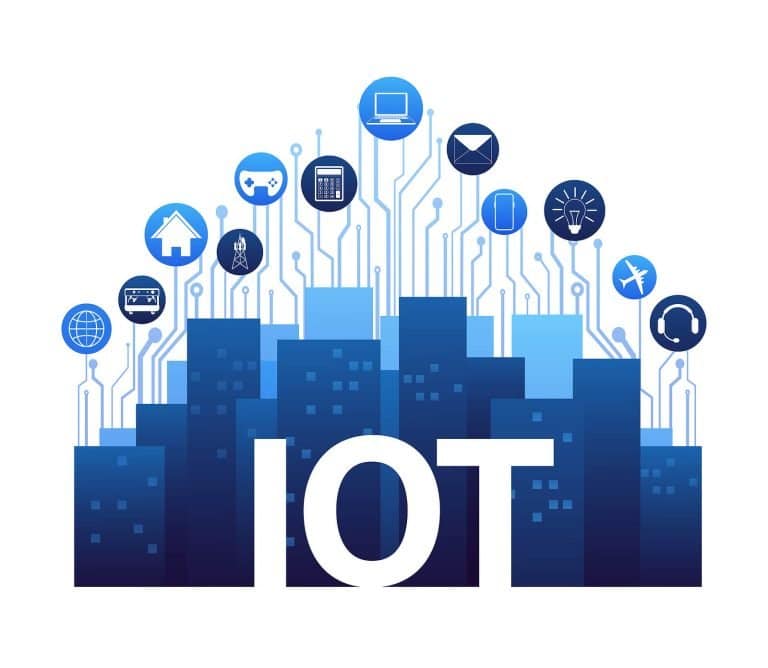What is Internet of Things? What is IoT?
The Internet of Things or IoT is a worldwide phenomenon, consisting of devices and technologies capable of observing, gathering, and exchanging information via network connectivity and a variety of communications protocols.
Table of Contents
ToggleThe Industrial Internet of Things or IIoT (also known as the Industrial Internet, the Fourth Industrial Revolution, or Industry 4.0) is a term that refers to the use of IoT technology in a production or business setting.
Similarly, the use of IoT devices and technology in the health and life sciences sphere is known as the Internet of Medical Things, or IoMT.
The IoT ecosystem currently includes around 27 billion connected objects -which is possibly a conservative estimate. Among the estimated, 41.6 billion devices or “things” that may be connected to the Internet by 2025 are items such as smart thermostats, light bulbs, home security systems, and motion sensors.
These exist in addition to technologies that we more typically associate with internet usage, such as laptops, desktop computers, and mobile phones.
While these more traditional computing and telecommunications technologies are part of the Internet of Things – it is a term more usually applied to devices and systems that would normally be considered “dumb” or incapable of meaningful interaction.
They are rendered “smart” through the incorporation into their makeup of technologies such as sensors (which can observe characteristics of the surrounding environment) and actuators (which can act in response to the observations made by sensors).
Connection to a wide area network (WAN) like the Internet enables these smart objects to transmit and receive information. It also allows systems associated with these objects to perform monitoring tasks and remote control of devices and technologies in the IoT meaning that smart systems may operate without human intervention and supply information to inform human actions.
During production, for example, sensors attached to components enable manufacturers to monitor data on their current performance and likely behavior in the future.
In predictive and preventative maintenance operations, this enables the fabricator to identify issues that are likely to cause product failure and rectify them before the damage occurs.
At the consumer level, wearable devices can provide vital performance and health information, helping the wearer to plan their exercise, diet, and other routines. This technology is continuously involving and creating new use cases and applications.
What is IoT Technology?
Strictly speaking, there is no single IoT technology. Rather, there’s a collection of related technologies that work together in the implementation of the networks and applications.
And the IoT technology “stack” consists of a range of technologies, standards, and applications, which govern the simple connection of objects to the Internet, all the various applications that use connected things, the data that connected objects gather and communicate, and the different mechanisms required to power these applications.
In other words, the IoT technology stack provides the infrastructure and protocols needed to move from devices and data to real-world applications and use cases. It consists of a number of different “layers.”
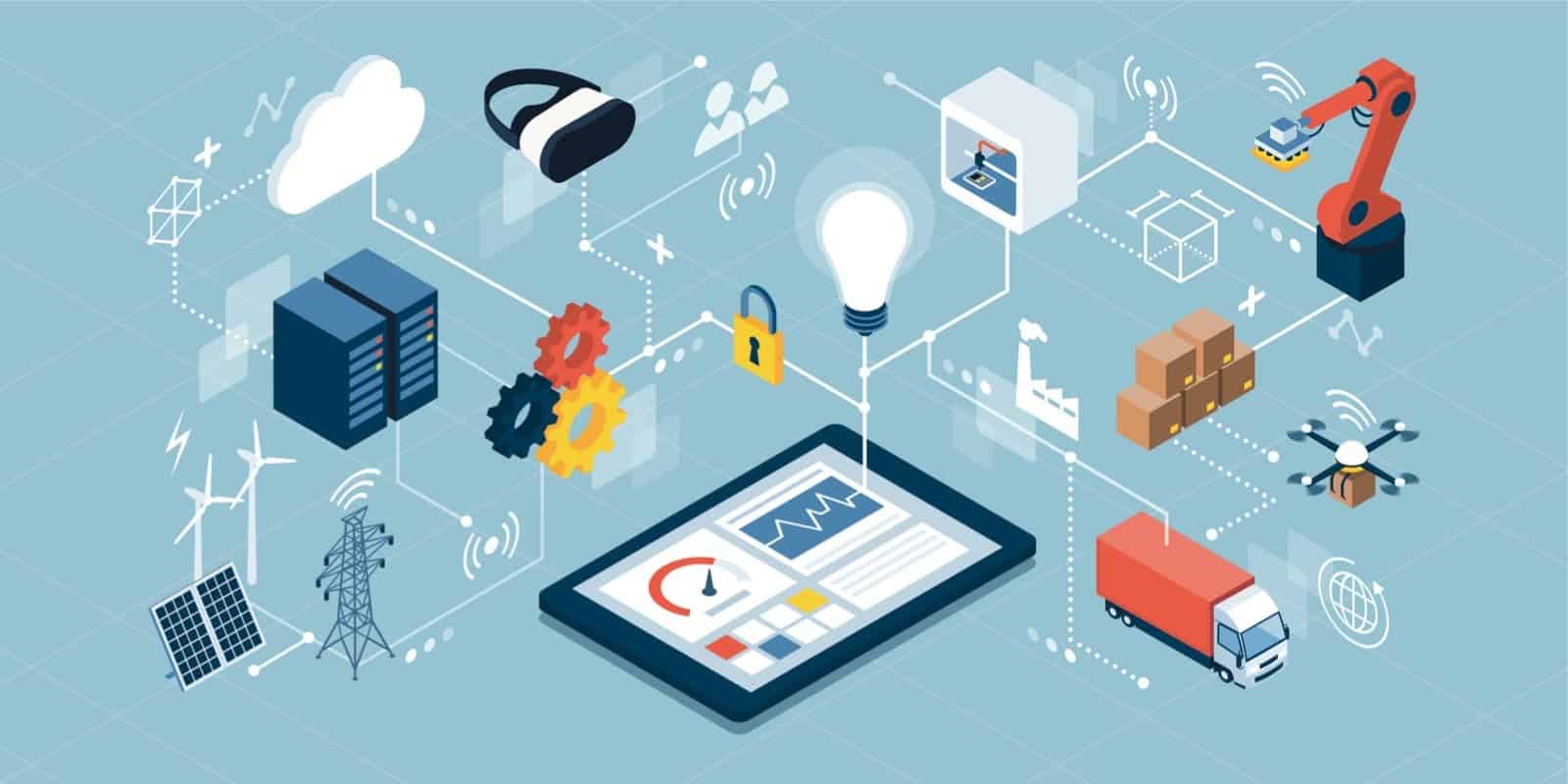
Layer 1: Devices Or Endpoints
The IoT device layer includes all the physical components that have first-hand contact with external environments. These are the elements that enable the devices to capture and communicate information, so in addition to the actual hardware, there’s a connectivity and communications component that enables physical objects and their controllers to interact and process data.

Sensors
One of the key device elements of the Internet of Things is the sensor -a device that detects, measures or indicates a specific physical quantity or characteristic.
These characteristics include light, heat, motion, moisture level, and pressure. A sensor has the ability to convert or transduce its observations of these quantities into a different form, such as electrical impulses. So an IoT sensor is a form of transducer.
IoT sensors can observe conditions in or around the device in which they are embedded, or in the environment of the physical item to which they are attached.
They can also communicate about these environmental events or changes in specific parameters to systems and other devices, which then can use this information for action, analysis, and reporting.
There are currently over 100 different types of sensors. They can be deployed individually or combined on a sensor board housing the various kinds of sensor circuitry required for a particular project or use case.
Actuators
Like sensors, actuators are a form of transducer, able to convert a signal in one form of energy into a signal in another form. As their name suggests, actuators are responsible for taking action or activating one mechanism or another.
Once an actuator receives an appropriate signal, it then sets in motion the processes required to act upon or within an environment, as set out by the parameters of its programming.
This ability to use environmental data as a trigger mechanism for specific action makes actuators a valuable tool in commercial or industrial automation and in consumer IoT applications.
There are many types of actuators and ways in which they can be used. For example, electrical actuators can turn their energy into mechanical torque, which can apply physical force. Hydraulic actuators can control valves on a water system in response to flow and leakage.
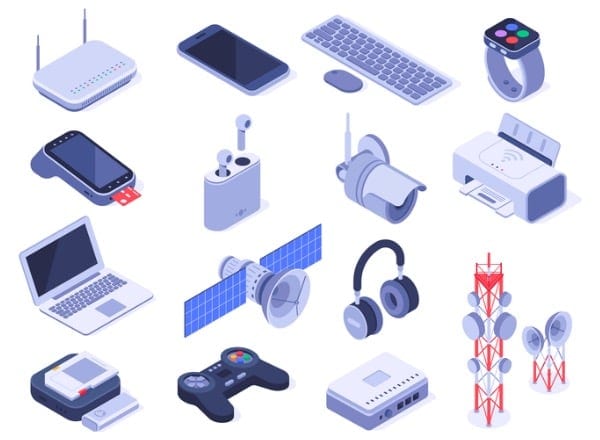
Layer 2: Gateways
The gateways sit on the intersection between devices, data, and platforms. They can be pure hardware, software, or a combination of the two, and come in many forms and sizes.
The gateway forms a broad layer bringing together multiple devices, technologies, solutions, and functions. And IoT gateways may serve several purposes, including:
- The aggregation of IoT network connectivity.
- Secure encryption and decryption of data.
- The translation of the various protocols governing the overall IoT technology landscape.
- The management and configuration of the devices.
- Facilitating data management and IoT edge computing.
- Remote control and management.
- The preliminary processing and aggregation of data.
In essence, then, the gateways bridge the Internet of Things device level and the technologies and environments where data from the IoT devices undergo analysis, processing, and harnessing.
Layer 3: Platforms
IoT platforms constitute a broad category of applications with multiple features. They are implemented as software, often known as middleware, which, as the name suggests, acts as the middle ground or medium between the more hardware-based layers of IoT devices and gateways and the business and application layers at the client or user end of the system.
There are currently over 400 different IoT platforms, many offering specialized features and functions to suit various use cases. For example, there are IoT Application Enablement Platforms, Application Development Platforms, Device Management Platforms (DMPs), data analytics platforms, and orchestration platforms.
Layer 4: Connectivity
The ability of IoT devices to communicate back and forth across the network is critical to their operation, and there are several protocols and technologies that enable this to occur. They include the following:
Bluetooth
Bluetooth is a wireless technology standard for exchanging data over short distances. It uses short-wavelength radio transmissions in the ISM band (from 2400–2480 MHz) from fixed and mobile devices, creating personal area networks (PANs) with high levels of security. Hands-free headsets, key dongles, and fitness trackers use the technology.
IPv4 and IPv6
Internet Protocol version 6 (IPv6) is the latest revision of the Internet Protocol (IP), which provides an identification and location system for computers on networks, and routes traffic across the Internet.
As a significant advance over the previous version (IPv4), IPv6 allocates enough address space to enable us to assign an IP address to every atom on the surface of the Earth -and still, have enough addresses left to cover over 100 other Earth-size planets. This easily allows for the continuing expansion of the IoT.

RFID (Radio Frequency ID)
A radio frequency identification or RFID system uses tags or labels attached to the objects to be identified. Two-way radio transmitter-receivers called interrogators or readers send a signal to a tag and read its response, usually transmitting their observations to a computer system running RFID software or RFID middleware.
Active RFID tags have an on-board battery and periodically transmit their ID signal. A battery-assisted passive (BAP) tag has a small battery on board and activates when in the presence of an RFID reader. Building access control and inventory systems routinely use RFID tags.
EnOcean
EnOcean is an energy-harvesting wireless technology, used primarily in building automation systems. The technology combines microenergy converters with ultra-low-power electronics and facilitates wireless communication between sensors, switches, controllers, and gateways.
GSM (Global System for Mobile communications)
GSM (Global System for Mobile communications) is an open, digital cellular technology used in transmitting mobile voice and data services. Cell phones, smart meters, asset tracking systems, and Machine-to-Machine or M2M communications may use terrestrial or satellite GSM.
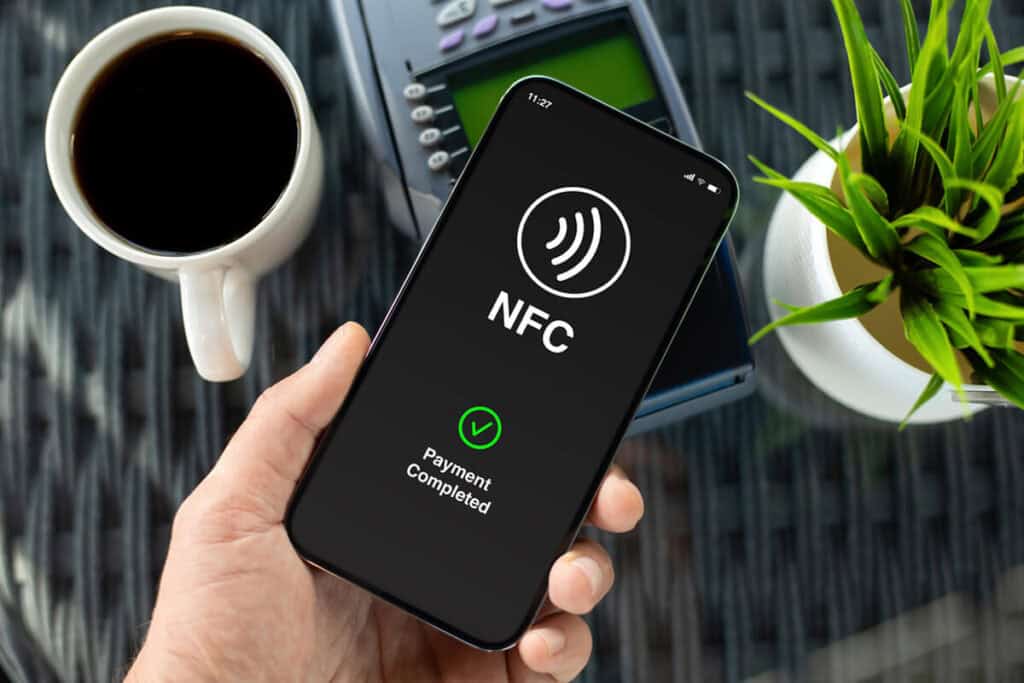
NFC (Near-Field Communications)
Near-Field Communications or NFC is a set of short-range wireless technologies, typically operating over distances of 10 cm or less. Each NFC initiator actively generates a radio frequency or RF field that can power a passive target.
This allows NFC targets to take very simple forms that don’t require batteries, such as tags, stickers, key fobs, or cards, which are often used in applications like access control and smart wallets.
WiFi (Wireless Fidelity)
WiFi technology enables electronic devices to exchange data over a computer network in a wireless manner using radio waves, including high-speed Internet connections. Routers, tablets, and internet-enabled mobile phones can use WiFi.
Weightless
Still under development, Weightless is a proprietary open wireless technology standard proposed for exchanging data between a base station and the thousands of machines around it.
The technology uses wavelength radio transmissions in unoccupied TV transmission channels (so-called “white space”), with high levels of security.
System Basics
Broadly speaking, an IoT system integrates four distinct components: sensors or devices, connectivity, data processing, and a user interface.
As we have already seen, sensors or devices collect data from their environment and may be standalone, bundled together on a sensor board, or be part of a device that does more than just sense things.
So, for example, while a smartphone incorporates multiple sensors (camera, accelerometer, GPS, etc.), it also acts as a data storage and communication device.
Cellular, satellite, WiFi, Bluetooth, and low-power wide-area networks (LPWAN) are just some of the media providing sensors and devices with connectivity to the cloud.
Connections typically occur via a gateway or router, or directly to the Internet via ethernet. Selecting the best connectivity option for a particular IoT use case requires a trade-off between power consumption, range, and bandwidth.
Once data from IoT sensors and devices gets to the cloud, data processing software performs various functions on it, such as aggregation, cleaning, or analysis.
Finally, a user interface translates this processed information into a meaningful form or some kind of recognizable activity. So a user interface might generate alerts in the form of email or text notifications or provide mobile app or web browser tools for proactive monitoring.
Some IoT applications will provide tools within the interface for users to directly affect the system, e.g., by making remote adjustments to temperature or lighting.

How IoT Works?
How does Internet of Things work? From a technical standpoint, an IoT ecosystem consists of web-enabled smart devices that use embedded technologies such as processors, sensors, and communication hardware to aggregate, transmit and act upon the data they collect from their environments.
Data sharing occurs via connection to an IoT gateway or other edge device, from which the information is either analyzed locally or sent to the cloud for analysis.
Depending on the project, devices may communicate with other related objects (in what’s known as Machine to Machine or M2M communication), and act on the information they receive from one another.
IoT devices do most of their work without human intervention, although people can interact with them for specific purposes, such as setting them up, giving them instructions, or directly accessing the data they collect.
Devices may also incorporate artificial intelligence (AI) and machine learning (ML) technologies to expand their range of capabilities and responsiveness.
That’s an overview. Let’s break it down in a little more detail.
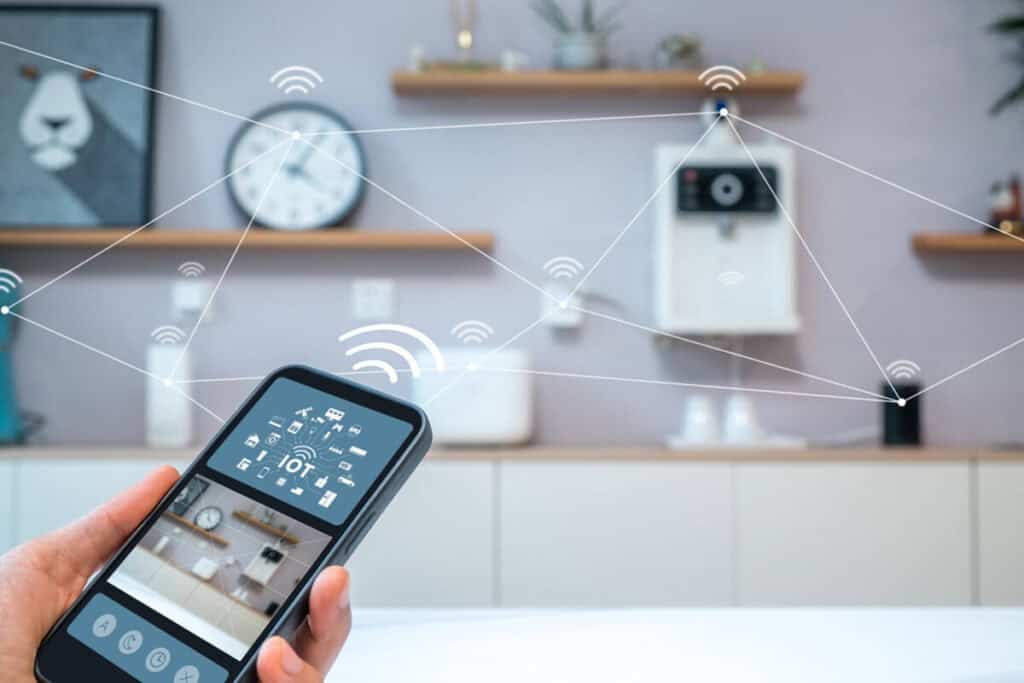
How Does IoT Work?
Central to how IoT works are the billions of connected devices making up the Internet of Things.
Since you can attach sensors and tiny computing equipment to just about anything, the range of items with embedded processing, sensing, and communication equipment is virtually limitless.
These devices use embedded hardware and software to send and receive data through various communication protocols. They may access a gateway to the Internet in a number of ways, including a smartphone, hub, or other networking device.
Connections can be established directly through a router or modem using wireless (WiFi), cellular, or wired methods like ethernet, cable, or power line networking.
Data from IoT devices is often sent to the cloud for aggregation and analysis. Users may access the end results via smartphone apps, web browsers, or dedicated displays.
With advances in internet connectivity, the sending and processing of sensor data is often almost instantaneous, allowing IoT devices to react in real or near-real-time.
Local communication methods for IoT devices to gain access to the cloud include:
- Bluetooth
- Bluetooth LE (Low Energy)
- 6LowPan (IPv6 over Low-Power Wireless Personal Area Networks)
- IEEE 802.15.4
- NFC (Near-Field Communication)
- ZigBee (a low-power, low-data rate wireless network used mainly in industrial settings)
- Z-wave
The connectivity mechanism, networking, and communication protocols typically depend on the specific IoT applications being deployed.
At the moment, smart devices generally ship with their own dedicated user interfaces and smartphone apps -and systems from different vendors generally don’t work in conjunction with one another.
This may change, as companies and industry groups are working to create standards and platforms to make it easier for devices to work together more seamlessly, and to improve security.
For example, the AllSeen Alliance was created by Qualcomm and other companies and is working on an open-source, platform-independent software framework called AllJoyn.
Cisco, Samsung, Intel, and others are working on an open-source platform called IoTivity. And CableLabs has been looking into a way to make cable boxes work as hubs to connect multiple devices.
In addition to standards and communication protocols, there are a number of IoT platforms, offering tools and features that enable smart devices to connect and securely interact with the cloud and other connected devices easily. Amazon Web Services (AWS) IoT is one example.
Another is Google’s Brillo/Weave, which consists of two main elements for the rapid implementation of IoT applications. Brillo is an Android-based operating system (OS) for the development of embedded low-power devices.
And Weave is an IoT-oriented communication protocol that serves as a communication language between devices and the cloud.
History of IoT
According to some sources, the Internet of Things was born between 2008 and 2009, at the point in time when more “things or objects” were connected to the Internet than people.
Other significant events in the history of Internet of Things include the invention of the first IoT device in the early 1980s and the origin of the term itself in 1999.
But the story of IoT as we know it began almost 200 years ago, as this IoT history timeline illustrates:
1832: In Russia, Baron Schilling creates an electromagnetic telegraph.
1833: In Germany, Carl Friedrich Gauss and Wilhelm Weber invent their own code to communicate over a distance of 1200 m within the region of Göttingen.
1844: Samuel Morse sends the first public telegraph message from Washington, D.C., to Baltimore (“What hath God wrought!”).
1876: Alexander Graham Bell receives the first patent for telephones in the United States.
1926: In an interview with Colliers magazine, Nikola Tesla makes the following observation: “When wireless* is perfectly applied, the whole Earth will be converted into a huge brain, which in fact it is, all things being particles of a real and rhythmic whole… and the instruments through which we shall be able to do this will be amazingly simple compared with our present telephone. A man will be able to carry one in his vest pocket.”
1955: Edward O. Throp constructs the first wearable computer -a device that could fit inside a shoe or cigarette pack, developed for predicting the spin of a roulette wheel.
1962: The Bell 103, developed by AT&T becomes the first commercial modem. Its invention would later lead to M2M (Machine to Machine) cellular modems, which bring cellular connectivity to IoT devices.
1965: At the MIT Lincoln Lab, two electronic computers communicate with each other for the first time.
1968: Theodore Paraskevakos proposes the concept of machine to machine technology (M2M). He would later go on to invent electric meters that could communicate with electricity grids.
1969: ARPANET (Advanced Research Projects Agency Network) -one of the forerunners of today’s Internet -goes online.
1973: While working at Motorola, Martin Cooper invents the first mobile phone. With it comes the introduction of cellular data and later, the data plans we’re familiar with today.
1974: The beginnings of TCP/IP (Transfer Control Protocol / Internet Protocol).
1984: Introduction of the Domain Name System (DNS).
1989: Tim Berners-Lee proposes the World Wide Web (WWW).
1990: For the October ’89 INTEROP conference, John Romkey creates a toaster that can be turned on and off over the Internet -in essence, the first IoT smart consumer device.
1991: The first SIM card for wireless networks is developed in Munich, Germany, allowing devices to connect with more than one direct source. This paved the way for the machine to machine (M2M) SIM cards which would be essential for IoT growth.
1993: Quentin Stafford-Fraser and Paul Jardetzky create the Trojan Room Coffee Pot, which was located in the “Trojan Room” of the Computer Laboratory at the University of Cambridge. It could monitor the coffee levels, with an image updated about three times a minute, which was sent to a server. This image was later put online for viewing after web browsers became capable of displaying images.
1998: The inTouch project developed at MIT by Scott Brave, Andrew Dahley, and Professor Hiroshi Ishii applies Synchronized Distributed Physical Objects to create a “tangible telephone” for long-distance haptic (touch-based) communication.
1999: While working at Procter & Gamble, Kevin Ashton coins the term “Internet of Things” during a presentation on RFID (Radio Frequency Identification).
2000: LG releases plans for a refrigerator with WiFi capability.
2003: Major companies start using the term “IoT” instead of M2M, also applying this change to sub-terminology such as M2M sim cards, which became IoT sim cards.
2003-2004: RFID (Radio Frequency ID) is deployed on a massive scale by the US Department of Defense in their Savi program, and by Walmart in the commercial sphere.
2005: The UN’s International Telecommunications Union ITU publishes its first report on the IoT.
2005: Created by Rafi Haladjian and Olivier Méve, and manufactured by the company Violet, the Nabaztag (now a part of Aldebaran Robotics) is launched as a WiFi-enabled robotic rabbit capable of alerting and speaking to users about stock market reports, news headlines, alarms, RSS feeds, and other information.
2008: The Internet Protocol for Smart Objects (IPSO) Alliance launches as a non-profit organization dedicated to bringing companies of all sizes together in the pursuit of wireless technology standards for the future.
2008: In the US, the Federal Communications Commission or FCC voted unanimously to approve opening the use of the “white space” spectrum.
2011: IPv6, the most recent version of Internet Protocol, is released, hugely expanding the number of IP addresses available to future generations of internet-enabled devices.
2012: General Electric (GE) coins the term “Industrial Internet.” The company went on to become a charter member of the Industrial Internet Consortium, a group dedicated to accelerating the development, adoption, and widespread use of interconnected machines and devices, intelligent analytics, and connected communications.
2013-2014: Thermostats and home lighting systems begin using sensors to accurately sense the surrounding environment.
2014: Sigfox sets up an Ultra Narrow Band Wireless data network in the San Francisco Bay Area.
2014: In Ireland, Dublin becomes the first IoT City. The Smart Dublin initiative uses IoT devices to implement a carbon-neutral stadium, hundreds of smart bins, sensors monitoring flood levels, and city sound monitoring sensors.
2017: the US Army Research Laboratory establishes an alliance to advance research in IoT technologies for army operations.
2018: IoT enters the healthcare and health insurance industries, allowing health care professionals to access patient data, and improving the quality of wearable medical devices.

Why is IoT Important?
Why is IoT important? The core concept -connecting everyday devices to the Internet and enabling them to collect and share information -introduces a multitude of convenient and profitable applications and use cases for individual citizens and corporate bodies alike.
On account of this, the speed of adoption of the Internet of Things model is accelerating. It’s estimated that there are 127 objects being hooked up to the IoT ecosystem every second. And IoT technology is on course to transform into a multi-trillion dollar industry in the near future.
In addition to connecting everyday objects and industry-specific tools to the Internet, the IoT provides its users with a platform to analyze the information that these items collect -often in real-time.
Cloud data storage for IoT devices and the ability to trigger an action or alert from a remote location enables this technology to be integrated into almost every industry.
The range of actions and applications available to devices of the IoT has serious applications for user convenience, workload efficiencies, and quality of life.
Typical IoT devices require little or no human intervention, allowing them to operate entirely on their own. This level of automation frees its users from unnecessary effort, making more time available for other issues.
In business, this can lead to significant gains in operational efficiency and considerable savings in time and money.
IoT systems such as smart lighting, which can turn themselves on and off in response to timing and environmental factors, can promote savings in electricity costs, reduce power and resource consumption, and have an overall beneficial effect on the environment.
Wearable devices like diet and fitness monitors enable users to keep track of their heart rate, body temperature, hydration, and nutrient levels, promoting good health and quality of life.
IoT devices in the home and personal entertainment sectors provide consumers with a rich and growing set of configuration and customization options for improved efficiency and convenience.
The Industrial IoT or IIoT is enabling environments such as automated factories, smart cities, and connected healthcare systems, extending the range of IoT possibilities to a larger stage.
As well as gathering, monitoring, and analyzing data on behalf of the user, the flow of information from IoT devices enables their controllers and manufacturers to isolate trends in this data that can suggest ways to improve the features of the device.
However, for IoT technology to reach its full potential, all devices will have to be able to communicate with each other, regardless of the company or brand that made or operates them.
Benefits/Advantages
The advantages of Internet of Things technology and applications extend to both individual consumers and corporate bodies.
At the level of personal use, increased connectivity is one of the key advantages of IoT. The integration of IoT tools and applications makes it possible to operate multiple “things” from one device, such as a smartphone.
Apps providing streamlined control of multiple functions translate into a decrease in the amount of time that users have to spend performing those same tasks.
IoT consumer devices are also designed with convenience and practicality in mind. Devices like the smart refrigerators or the Amazon Dash button can simplify and automate the routine processes of ordering food and household items.
Things like wearable health and fitness monitors can provide users with real-time observations and recommendations they need to maintain a healthier lifestyle.
And with the incorporation of artificial intelligence (AI) and machine learning (ML) technologies, IoT devices gain the ability to adapt to the likes and dislikes of a user and tailor their services accordingly.
For businesses, IoT gives organizations the ability to collect data from a worldwide network of sources and use advanced analytics to uncover business insights, fresh opportunities, and new business models.
Real and near-real-time analytics and response capabilities provide enhanced options for organizations to predict needs before they arise and to act with precision based on insights from the IoT network.
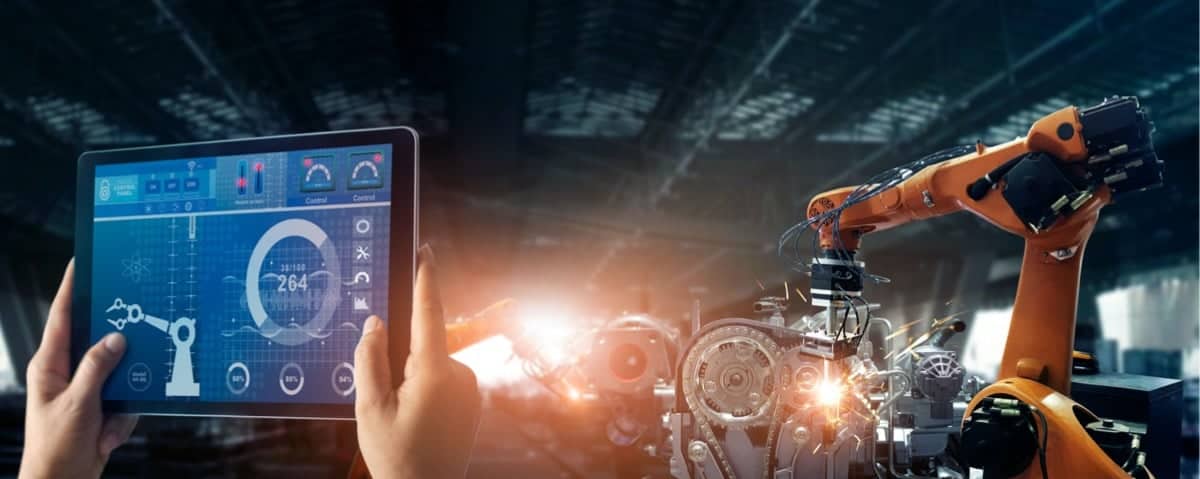
Operationally, data from IoT monitoring coupled with advanced analytics, can facilitate predictive and preventative maintenance, promote operational efficiency, and reduce operational costs.
IoT technologies and network communications tools are also facilitating the transition from office-based to remote working models -a move that’s particularly significant, in light of the ongoing COVID-19 pandemic.
Other benefits of IoT impact directly on the customer experience. Data collected by IoT devices can help in predicting what customers need and want, enabling businesses to tailor their product and service offerings to keep pace.
Real-time and recorded information from customer interactions with products and services can be used in fine-tuning customer experiences and customer service delivery.
Given these observations, the continuing growth of IoT should come as little surprise. The number of businesses that use IoT technologies has increased from around 13% in 2014 to over 25% today.
And the worldwide number of IoT-connected devices is projected to increase to around 43 billion by 2023. With technological advancements, IoT technology will become easier to implement, opening the door for a wider variety of organizations and individuals to benefit from IoT applications.
One element of the IoT and its impact that cuts across all demographics is its implication for smart city and environmental planning. IoT developers are coming up with new ways to use IoT technology in monitoring conditions such as traffic flow, air quality, electricity and water consumption, and environmental factors.
These efforts may assist city planners and residents in designing and implementing solutions for sustainability and resource conservation.

Future of IoT
Most IoT deployments are at an early stage for now, largely due to the relative immaturity of sensor technology, machine-learning powered analytics, 5G, and other communications and connectivity protocols.
But as the price of sensors and communications technologies continue to drop, organizations will find it cost-effective to add more devices to the IoT, contributing to its rapid growth. And as the number of connected devices continues to rise, smart products and services will play an increasing role in our living and working environments.

What Else Can We Observe About the Future of Internet of Things?
In the industrial sphere, increased network agility, integrated artificial intelligence (AI), and the capacity to deploy, automate, orchestrate, and secure diverse use cases at massive scales will fuel advances to the Industrial Internet of Things (IIoT).
Increased network capacity and AI will empower organizations to harness huge volumes of actionable data in the automation of diverse business processes.
Advances in technology will enable service providers to extend their reach into the IT and web-scale markets, opening up new streams of revenue.
Technological advancement may also usher in a new age of human to machine interactivity, or Human 4.0 -an ecosystem enabling humans to engage with machines and each other over great distances in real-time, using immersive mixed reality applications and haptic technologies to generate similar sensory experiences to those that they experience locally.
This technology vision has the potential to create new opportunities within remote learning, surgery, and repair, by using 3D audio and haptic sensations as the foundations for the next generation of mobile platforms.
With the evolution of wireless and mobile communications technologies, the move toward smart cities and ever-smarter vehicles will accelerate.
Though still in its infancy, 5G networking technology holds the promise of finally making autonomous or self-driving cars and trucks a safe and practical reality, through improved machine to machine communications and real or near real-time response.
Likewise, the ability to accommodate vastly greater numbers of connected devices on a single network could make smart city and infrastructure initiatives easier to develop and deploy.
5G, for example, offers the ability to fit as many as one million devices in a square kilometer, making it possible to use an enormous number of IoT sensors in a very small area.
Note that 5G isn’t the only communications technology likely to play a major role in connectivity for the future IoT. In fact, it’s projected that less than half of all the information generated by IoT devices will need to be transferred to centralized data centers.
For this reason, local area networks offering short-range communications options for edge computing deployments will be critical, as well. In addition, satellite communications will be involved, especially in less densely populated rural areas, and for applications where the location accuracy of moving assets is critical.
Security and interoperability will have to play central roles in any viable future of the Internet of Things. Both aspects of the current IoT ecosystem are lacking in maturity and rigor, and constitute two of the principal disadvantages of the Internet of Things in its present form.
With so many competing platforms, standards, and vendors in the field, the future will need to concentrate on establishing a common medium or protocol by which technologies from different device makers, software companies, and network operators can seamlessly communicate and interact.
This will require consultation and collaboration between various parties, and the establishment of interoperability standards that will stand the test of time and service, by being future-proof and secure.
This last point is particularly relevant, as an increase in the number and nature of IoT devices and technologies could generate a future bonanza for hackers and cybercriminals.
In particular, if security hardening of IoT devices and infrastructure remains a low priority for manufacturers, the incidence of Distributed Denial of Service (DDoS) attacks facilitated by malware-infected armies of IoT devices will increase.
And with users and their devices contributing ever-increasing streams of valuable data to the cloud (and increasingly unable to monitor all of their devices), matters of data security and privacy will have to be fully addressed.



